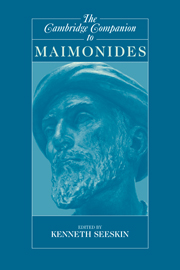Book contents
- Frontmatter
- Introduction
- 1 Moses Maimonides: An Intellectual Portrait
- 2 The Guide and Maimonides’ Philosophical Sources
- 3 Metaphysics and Its Transcendence
- 4 Maimonides’ Epistemology
- 5 Maimonides’ Philosophy of Science
- 6 Maimonides’ Moral Theory
- 7 Maimonides’ Political Philosophy
- 8 Jurisprudence
- 9 Bible Commentary
- 10 Spiritual Life
- 11 Maimonides: Esotericism and Educational Philosophy
- 12 Maimonides--A Guide for Posterity
- Bibliography
- Index
2 - The Guide and Maimonides’ Philosophical Sources
Published online by Cambridge University Press: 28 August 2006
- Frontmatter
- Introduction
- 1 Moses Maimonides: An Intellectual Portrait
- 2 The Guide and Maimonides’ Philosophical Sources
- 3 Metaphysics and Its Transcendence
- 4 Maimonides’ Epistemology
- 5 Maimonides’ Philosophy of Science
- 6 Maimonides’ Moral Theory
- 7 Maimonides’ Political Philosophy
- 8 Jurisprudence
- 9 Bible Commentary
- 10 Spiritual Life
- 11 Maimonides: Esotericism and Educational Philosophy
- 12 Maimonides--A Guide for Posterity
- Bibliography
- Index
Summary
Maimonides lived in the Islamicate civilization of twelfth-century Spain/Andalusia, Morocco, and Egypt. He was heir to a rich body of philosophical, theological, and theosophical literature, traditions that converged and diverged at different points, depending on their origins and target audiences. Following in the footsteps of Christian theology, the Muslim theologians or mutakallimūn began within a hundred years of Muhammad's death. By the tenth century, Muslim philosophy and theosophy had appropriated their largely pagan Greek origins and established themselves as distinctive systems of thought. Arabic translations were made of the Greek philosophical corpus available in the ninth century: all of Aristotle with the possible exception of his Politics, and little directly of Plato except for his Timaeus, Republic, and Laws. Commentaries on Aristotle were also translated, as were works by Plotinus and Proclus that were passed off as Aristotle's. Falãsifa, like the tenth-century Alfarabi, the eleventh-century Avicenna, and the twelfth-century Averroes, incorporated so much of these teachings that Maimonides felt he could rely on them for his knowledge of Aristotle.
- Type
- Chapter
- Information
- The Cambridge Companion to Maimonides , pp. 58 - 81Publisher: Cambridge University PressPrint publication year: 2005
- 6
- Cited by



